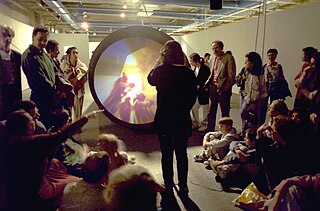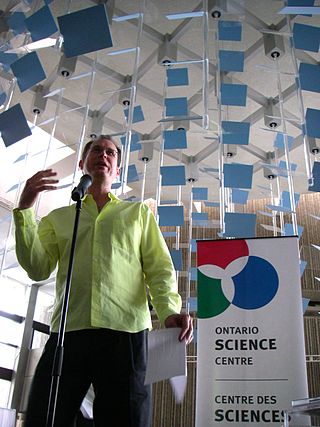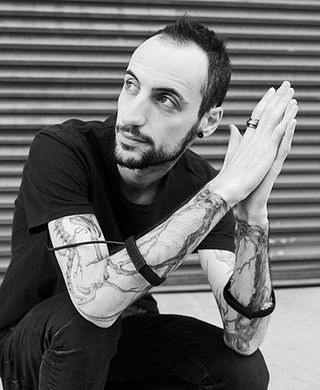
William Stephen George Mann is a Canadian engineer, professor, and inventor who works in augmented reality, computational photography, particularly wearable computing, and high-dynamic-range imaging. Mann is sometimes labeled the "Father of Wearable Computing" for early inventions and continuing contributions to the field. He cofounded InteraXon, makers of the Muse brain-sensing headband, and is also a founding member of the IEEE Council on Extended Intelligence (CXI). Mann is currently CTO and cofounder at Blueberry X Technologies and Chairman of MannLab. Mann was born in Canada, and currently lives in Toronto, Canada, with his wife and two children.

Digital art refers to any artistic work or practice that uses digital technology as part of the creative or presentation process. It can also refer to computational art that uses and engages with digital media.

Interactive art is a form of art that involves the spectator in a way that allows the art to achieve its purpose. Some interactive art installations achieve this by letting the observer walk through, over or around them; others ask the artist or the spectators to become part of the artwork in some way.

Electronic art is a form of art that makes use of electronic media. More broadly, it refers to technology and/or electronic media. It is related to information art, new media art, video art, digital art, interactive art, internet art, and electronic music. It is considered an outgrowth of conceptual art and systems art.

Internet culture is a culture based on the many ways people have used computer networks and their use for communication, entertainment, business, and recreation. Some features of Internet culture include online communities, gaming, and social media. Due to the massive adoption and widespread use of the Internet, the impact of Internet culture on society and non-digital cultures has been extensive. The encompassing nature of the Internet culture has led to the study of different elements such as social media, gaming and specific communities, and has also raised questions about identity and privacy on the Internet.

David Rokeby is an artist who has been making works of electronic, video and installation art since 1982. He lives with his wife, acclaimed pianist Eve Egoyan, and daughter, Viva Egoyan-Rokeby, in Toronto, Canada.
The Boston Cyberarts Festival used to be the largest festival of digital art, performance and film created using new technology in the USA. Around 22,000 people attended the festival in 2007 where they witnessed the work of over 200 artists from all over the world.
Digital anthropology is the anthropological study of the relationship between humans and digital-era technology. The field is new, and thus has a variety of names with a variety of emphases. These include techno-anthropology, digital ethnography, cyberanthropology, and virtual anthropology.
Kenneth E. Rinaldo is an American neo-conceptual artist and arts educator, known for his interactive robotics, 3D animation, and BioArt installations. His works include Autopoiesis (2000), and Augmented Fish Reality (2004), a fish-driven robot.

Maurice Benayoun is a French new-media artist, curator, and theorist based in Paris and Hong Kong.

Mary Flanagan is an artist, author, educator, and designer. She pioneered the field of game research with her ideas on critical play and has written five books. She is the founding director of the research laboratory and design studio Tiltfactor Lab and the CEO of the board game company Resonym. Flanagan's work as an artist has been shown around the world and won the Award of Distinction at Prix Ars Electronica in 2018.

Cornelia Sollfrank is a German digital artist, she was an early pioneer of Net Art and Cyberfeminism in the 1990s.

SixthSense is a gesture-based wearable computer system developed at MIT Media Lab by Steve Mann in 1994 and 1997, and 1998, and further developed by Pranav Mistry, in 2009, both of whom developed both hardware and software for both headworn and neckworn versions of it. It comprises a headworn or neck-worn pendant that contains both a data projector and camera. Headworn versions were built at MIT Media Lab in 1997 that combined cameras and illumination systems for interactive photographic art, and also included gesture recognition.

Hybrid art is a contemporary art movement in which artists work with frontier areas of science and emerging technologies. Artists work with fields such as biology, robotics, physical sciences, experimental interface technologies, artificial intelligence, and information visualization. They address the research in many ways such as undertaking new research agendas, visualizing results in new ways, or critiquing the social implications of the research. The worldwide community has developed new kinds of art festivals, information sources, organizations, and university programs to explore these new arts.

CyberArts International was a series of conferences dealing with emerging technologies that took place during years 1990, 1991, and 1992 in Los Angeles and Pasadena, California. The gatherings brought together artists and developers in all types of new media, including software engineers, electronic musicians, and graphic artists to explore what was a new field at the time, digital media collaborations.
Cybernetic art is contemporary art that builds upon the legacy of cybernetics, where feedback involved in the work takes precedence over traditional aesthetic and material concerns. The relationship between cybernetics and art can be summarised in three ways: cybernetics can be used to study art, to create works of art or may itself be regarded as an art form in its own right.

Ars Electronica Linz GmbH is an Austrian cultural, educational and scientific institute active in the field of new media art, founded in Linz in 1979. It is based at the Ars Electronica Center (AEC), which houses the Museum of the Future, in the city of Linz. Ars Electronica's activities focus on the interlinkages between art, technology and society. It runs an annual festival, and manages a multidisciplinary media arts R&D facility known as the Futurelab. It also confers the Prix Ars Electronica awards.

Marco Donnarumma is an Italian performance artist, new media artist and scholar based in Berlin. His work addresses the relationship between body, politics and technology. He is widely known for his performances fusing sound, computation and biotechnology. Ritual, shock and entrainment are key elements to his aesthetics. Donnarumma is often associated with cyborg and posthuman artists and is acknowledged for his contribution to human-machine interfacing through the unconventional use of muscle sound and biofeedback. From 2016 to 2018 he was a Research Fellow at Berlin University of the Arts in collaboration with the Neurorobotics Research Lab at Beuth University of Applied Sciences Berlin. In 2019, together with bioartist Margherita Pevere and media artist Andrea Familari, he co-founded the artists group for hybrid live art Fronte Vacuo.

Amy Karle is an American artist, bioartist and futurist. She creates work that looks forward to a future where technology can support and enhance the human condition. She was named in BBC's 100 women, as one of the 100 inspiring and influential women from around the world for 2019. Her work questions what it means to be human, with an emphasis on exploring the relationship between technology and humanity; particularly how technology and biotechnology impacts health, humanity, evolution and the future. She combines science and technology with art and is known for using live tissue in her works. Karle uses body based investigation and the actual science and technology as tools in the process of creating the artworks. Amy Karle's artworks include new media art, bioart, computational art, hybrid art, body art, durational performance art, installation art, and garments and wearable art. Karle is most noted for her artworks merging the body and technology, including Regenerative Reliquary, Internal Collection, Biofeedback artwork. She regularly exhibits her artworks in major museums around the world including in Ars Electronica, The Centre Pompidou, The Mori Art Museum, The Smithsonian Institution.
Victor Acevedo is an American artist best known for his digital work involving printmaking and photography. He was introduced to computer graphics while attending Gene Youngblood's survey class (based on his book Expanded Cinema) at Art Center College of Design in Pasadena, California.














